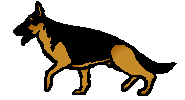Basic New Owner Information


VOICE:
The tone of your voice will indicate your approval or disapproval of a
particular behavior. The volume or modulation of your voice will also help
communicate the importance or urgency in responding with a particular behavior.
Never shout at your dog. This may scare a weak dog. A frightened or intimidated
dog stops thinking, therefore, stops learning. Use of voice tone and volume is
extremely important in training a dog. Train in a casual normal tone and volume,
thus, the dog learns to respond to this. If the dog is taught only by shouting,
then the dog will be conditioned to only respond to shouting. No one wants to be
shouting inside their home at their dog all the time.
PRAISE:
Praise is used to positively reinforce a particular behavior we want
repeated. We praise by saying, "Good" followed by the command given. By
repeating the command along with the word "Good" you are reinforcing what the
dog should be doing plus praising him at the same time. When praising, it is
important your voice tone is upbeat, friendly and conveys satisfaction.
THE INSTRUCTIVE REPRIMAND:
An instructive reprimand accomplishes two things at the same time: 1) it
informs the dog that the behavior which just occurred does not meet with your
approval, and 2) redirects the dog's behavior to what you want him to do. Too
many people only reprimand without redirecting, thus, the dog tends to repeat
the wrong behavior since he was not shown what he was suppose to be doing.
KEEPING TEMPERAMENT IN BALANCE:
It is important that the dog's temperament remains in balance at all times
during training. When correction is given, it is followed by praise when the dog
follows the command. Again, praising after the dog accomplishes the redirective
command, the dog will keep a good attitude about his acceptance of training.
Then the dog will remain upbeat and positive about training.
ESTABLISHING THE LEADERS:
Most dogs will attempt to dominate whomever they can in their pack. Since
you, your immediate family or anyone else which lives with you or visits
regularly is considered by the dog to be the dog's pack members, he will tend to
assert his dominance upon these people. Canine dominance may be seen in the form
of biting for attention, grabbing onto clothing with teeth and barking or
jumping up. This must be corrected immediately or the dog will feel he is the
leader of the pack. This can lead to further problems with behavior because he
feels he is alpha. Don't forget to give the redirective command after the
correction.
CONSISTENCY IN TRAINING:
Dogs learn through association. Verbal and hand signal commands must be
consistent throughout the training by all members of the family. If the dog
receives different or mixed signals, he will become confused, anxious and will
stop learning. Be sure only members of your family communicate with your dog
plus they know what you are teaching and how to reinforce your training. Don't
let strangers or occasional guests boss your dog around. One of the major
problems we have after training a dog is that when the dog goes home, different
members of the household use variations of the command words plus are not
consistent about utilizing the same word for the same action required, in
addition to this problem, some members of the family will allow the dog to
disobey the command by ignoring the request and then the dog learns he does not
have to respond when first asked, nevertheless, quickly.
BACK TO ADULT DOGS FOR SALE
BACK TO PUPS FOR SALE
BACK TO STUD SERVICE
BACK TO TRAINING PAGE
BACK TO GOOD INFORMATION PAGE
BACK TO HOME PAGE